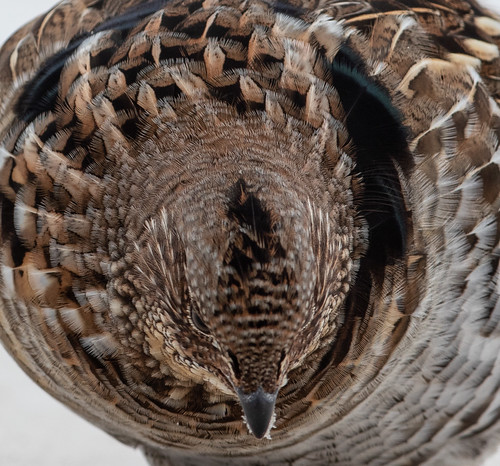In the past couple of years, I’ve had pretty good luck taking photos of a couple of individual Ruffed Grouse—one of those species I particularly love—at the Sax-Zim Bog, so my ears pricked up as I read an email from James Stone of Northome. He wasn’t looking forward to the end of mushroom picking, but otherwise seemed to be looking forward to the first frost. He wrote:
I believe we will freeze the lower ground tonight, which will put an end to my chanterelle picking and maybe bring the ruffed grouse broods out of wherever they’ve been prospecting. There was a period of time—2 weeks or so, about 6 weeks back—that the ruffed grouse hens were moving their broods around and I was chasing them off blacktops and watching them take dust baths on the forest gravels. Since then, they’ve virtually disappeared and of course I always have this concern about West Nile. In 2007 the ruffed grouse populations crashed statewide; the DNR pretended the crash never happened (license sales) but consequent news out of Pennsylvania gave me the idea that WN virus was probably the culprit. And I can testify to the abundance of mosquitos this summer, even in the sandy chanterelle ground.
Tragically, James is right about how West Nile Virus has affected grouse. According to the Pennsylvania Game Commission, between 1978 and 2000, flush rates for ruffed grouse reported by hunters in Pennsylvania declined by 2 percent as forests aged beyond the early succession the birds need for food and shelter. But then, between 2001 and the end of 2018, flush rates plummeted by 54 percent, due to West Nile Virus.
When West Nile first appeared in New York City in 1999, fears of a pandemic for humans were extreme—I went down to New Orleans in 2001 and when birding here and there, saw many people wearing mosquito netting from head to toe. Yet in the worst year, 2003, there were fewer than 10,000 human cases nationwide, and nowhere near as many deaths. Indeed, in the 20 years since West Nile Virus was first detected in the US, a total of about 2,300 Americans have died from it. For comparison, during on May 1 of this year—just that one 24-hour period—over 2,909 people died of COVID-19, and even as we developed better treatments for people with the virus, there were a great many single days this summer when more than 1,000 people died. In just six months, COVID-19 has killed almost 2 orders of magnitude more people in the US than West Nile Virus has in more than two decades.
COVID-19 is airborne, which makes it hard for people to infect wildlife. West Nile Virus made it into wildlife much more easily, because it’s transmitted via mosquitoes, and was far more lethal to many wild species than it is to humans. Jason Bittel reports in a June 4, 2020, article for National Geographic that even as West Nile Virus was ebbing in humans:
The virus lingered in the woods … spreading from bird to bird—not just ruffed grouse but more than 300 species, causing brain lesions, and killing millions of birds. "Some of our best-loved backyard birds are missing,” [Pennsylvania Game Commission biologist Lisa] Williams says. Crows, owls, and blue jays are among those that have suffered severe losses to West Nile virus. Ruffed grouse numbers have fallen in states from Minnesota and Michigan to North Carolina and New Jersey, a problem exacerbated by climate change.
In Pennsylvania, Williams says, ruffed grouse declined by an estimated 23 percent between 2017 and 2018—¬“a horrendous year.” West Nile virus, she adds, is “a classic climate change disease.” Earlier springs in the forests give mosquitoes more time to pump out larvae, and increases in precipitation, also spurred by climate change, create more stagnant pools in which the insects can reproduce.
All of us enjoy reminiscing about those mythical “good old days” when life was ever so much better, either because we were unaware of how bad those days were for others or because we’ve forgotten the bad elements. Grouse have always undergone dramatic population swings in regular cycles, and I always remember when I complain that I haven’t seen any in a while that we may be in the low part of their cycle. But even cyclical species can truly decline, bringing the low swings far lower than historical lows, and the highs much lower than the historical highs. That is happening with Ruffed Grouse.
 |
| Population trend of Ruffed Grouse in Minnesota between 1966 and 2012 (data from the BBS is harder to get in recent years, thanks I think to budget cuts). |
This splendid bird may not be our state bird, and hunters may be losing interest in it—small game license sales have been declining in Minnesota for the past 20 years, and last year saw the smallest number of grouse hunters since the DNR started keeping records in 1969. Grouse hunters and non-hunters alike need to join forces to ensure that the DNR has the funding to protect grouse habitat and to keep tabs on exactly what is happening to this wonderful species.


